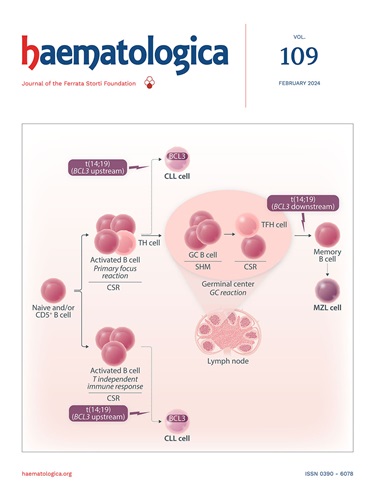Long-term outcomes in FLT3-mutated acute myeloid leukemia after frontline hypomethylating agent, venetoclax and a FLT3 inhibitor.
IF 7.9
1区 医学
Q1 HEMATOLOGY
引用次数: 0
Abstract
Triplet regimens with a hypomethylating agent, venetoclax and a FLT3 inhibitor yield high rates of response in newly diagnosed FLT3-mutated AML. However, the long-term outcomes and patterns of relapse with these triplet regimens are not well-established. In this retrospective analysis, 73 patients with newly diagnosed FLT3-mutated AML received a frontline FLT3 inhibitor-containing triplet regimen. The composite complete remission (CR) and CR with incomplete hematologic recovery (CRi) rate was 93%. Next-generation sequencing FLT3-ITD MRD negativity (sensitivity: 0.005%) was achieved in 60% of patients after cycle 2 and 90% after cycle 4. The estimated 3-year relapse-free survival (RFS) for FLT3-ITD-mutated and FLT3 TKD-mutated AML was 38% and 76%, respectively, and the 3-year overall survival (OS) was 45% and 76%, respectively. Neither age, NPM1 co-mutation, ELN 2022 risk, nor allogeneic stem cell transplantation in first remission significantly impacted OS. Baseline RAS pathway mutations were associated with poor long-term survival (3-year OS 22% versus 63% without RAS pathway mutation). FLT3 wild type relapses accounted for 65% of relapses, and new RAS pathway mutations were observed in 24% of relapses. Outcomes were poor after relapse (median OS of 6.1 months), particularly for those with persistently detectable FLT3 mutations. Triplet combinations of an HMA, venetoclax and a FLT3 inhibitor result in durable remission and encouraging long-term OS in older adults with newly diagnosed FLT3-mutated AML. However, better strategies to prevent FLT3 wild type relapses and to overcome RAS pathway-mediated resistance are still needed.FLT3突变的急性髓系白血病在一线低甲基化药物、venetoclax和FLT3抑制剂治疗后的长期结局。
低甲基化剂、venetoclax和FLT3抑制剂的三联疗法对新诊断的FLT3突变AML有很高的应答率。然而,这些三联疗法的长期结果和复发模式尚不明确。在这项回顾性分析中,73名新诊断的FLT3突变AML患者接受了一线含FLT3抑制剂的三联疗法。复合完全缓解(CR)和CR伴不完全血液学恢复(CRi)率为93%。下一代测序FLT3-ITD MRD阴性(敏感性:0.005%)在第2周期后达到60%,在第4周期后达到90%。FLT3- itd突变AML和FLT3- tkd突变AML的3年无复发生存率(RFS)分别为38%和76%,3年总生存率(OS)分别为45%和76%。首次缓解期的年龄、NPM1共突变、ELN 2022风险和同种异体干细胞移植均未显著影响OS。基线RAS通路突变与较差的长期生存相关(3年生存率为22%,而没有RAS通路突变的患者为63%)。FLT3野生型复发占复发的65%,在24%的复发中观察到新的RAS通路突变。复发后的结果很差(中位OS为6.1个月),特别是那些持续可检测到FLT3突变的患者。HMA、venetoclax和FLT3抑制剂的三重组合可导致新诊断的FLT3突变AML的老年人持久缓解和促进长期OS。然而,仍然需要更好的策略来防止FLT3野生型复发和克服RAS途径介导的耐药。
本文章由计算机程序翻译,如有差异,请以英文原文为准。
求助全文
约1分钟内获得全文
求助全文
来源期刊

Haematologica
医学-血液学
CiteScore
14.10
自引率
2.00%
发文量
349
审稿时长
3-6 weeks
期刊介绍:
Haematologica is a journal that publishes articles within the broad field of hematology. It reports on novel findings in basic, clinical, and translational research.
Scope:
The scope of the journal includes reporting novel research results that:
Have a significant impact on understanding normal hematology or the development of hematological diseases.
Are likely to bring important changes to the diagnosis or treatment of hematological diseases.
 求助内容:
求助内容: 应助结果提醒方式:
应助结果提醒方式:


